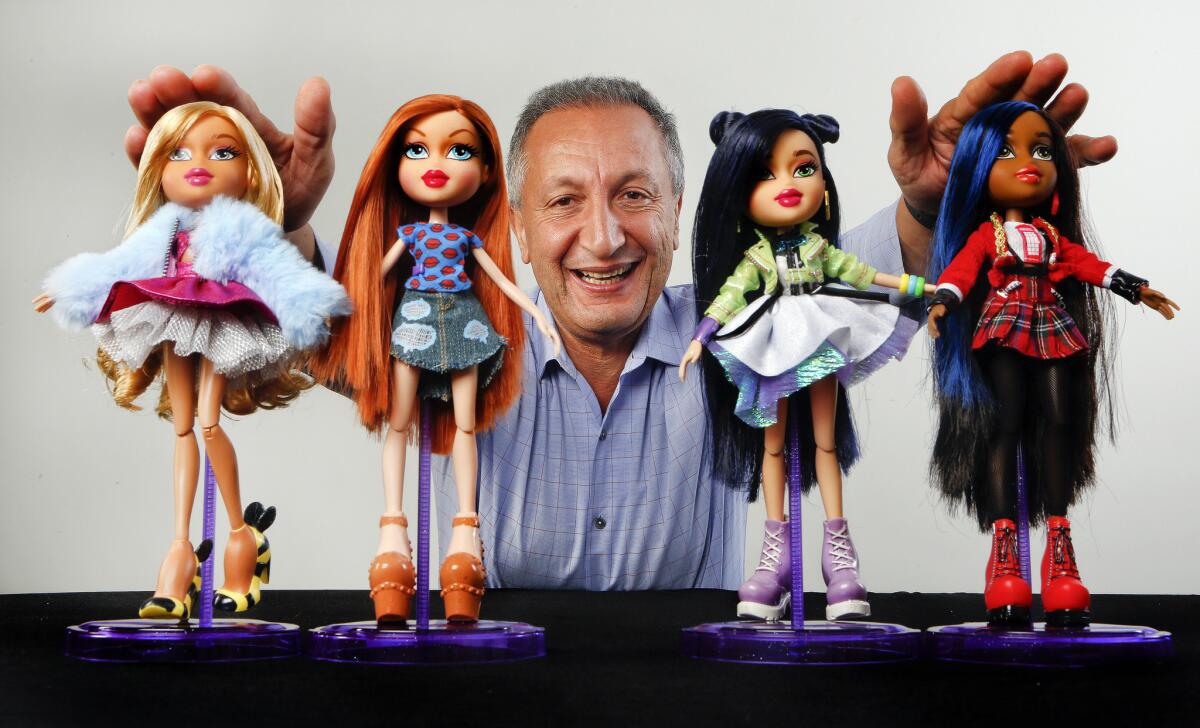Bratz dolls look to make a comeback with an updated vibe

Isaac Larian, chief executive of MGA Entertainment, says, “Bratz nowadays is more Taylor Swift than Britney Spears.”
At MGA Entertainment’s toy design center, an inspiration board features of-the-moment celebs: model Cara Delevingne, rapper Nicki Minaj and singer Selena Gomez.
Less au courant is the name emblazoned in neon cursive at the board’s center: Bratz.
Fifteen years after their debut, the pouty-lipped dolls with huge heads and attitude to spare are back.
Bratz dolls were once wildly popular, but toy-land courtroom warfare and changing tastes sent them diving for cover. Now, the girls have returned to stores with a different look and an updated vibe.
This time, the dolls are more covered up. There are fewer midriff-baring crop tops or faces laden with eye shadow. Instead, dolls now come with smartphones and accessories printed with emojis.
It’s all part of keeping up with how girls and their tastes have evolved since Bratz first hit the scene in 2001, said Isaac Larian, chief executive of MGA Entertainment, which makes Bratz.
“Girls have changed. They demand a lot more than they did before,” Larian said. “Bratz nowadays is more Taylor Swift than Britney Spears.”
The relaunch of Bratz is yet another effort by the Van Nuys company to recapture the appeal of its marquee brand after a bitter 11-year battle with Mattel Inc., the El Segundo toy giant.
The new Bratz include a line of #SelfieSnaps dolls with tiny cameras and tops emblazoned with the word “Selfie.” MGA also rolled out Bratz-starring YouTube videos and its first app, in which girls can create their own digital Bratz characters. One toy, the #SelfieSnaps Photobooth, has a slot for children to place a smartphone so that they can take real photos of their dolls.
Target partnered with the company to allow shoppers to customize their own dolls on the retailer’s website. Parents and kids can select outfits and hair and eye color.
Children now “demand digital innovation,” Larian said. “More and more kids are watching content online, whether it’s YouTube or Netflix, and Bratz has its own YouTube channel.”
This isn’t Bratz’s first comeback attempt.
MGA tried to revamp the line in 2010, making the dolls taller and introducing fresh logos. But MGA pulled Bratz in 2014 after lackluster customer interest.
Larian said Bratz lost its way, opting for cheaper doll hair, fewer accessories in each box and a look that didn’t match Bratz’s rebel attitude.
“We basically made Bratz similar to what was comparative in the market at the time — mermaids and princesses,” he said. “And Bratz is not Disney princesses.”
In MGA’s design center, eight toy designers and six sewers create and stitch new looks for future Bratz dolls that hew to the brand’s rebel attitude.
One designer, Danna Darma, sat sketching ideas for the character named Jade. Next to Darma sat rows of doll heads on spikes, which are used to experiment with hairstyles.
“Jade is kind of the crazy one, with like dark blue hair,” said Darma, who bears a resemblance to the character with hot pink streaks in her own hair.
Bratz is still important to MGA, which was little known until it launched the doll brand that captured the interest of older girls. But even Larian acknowledges that the brand isn’t as crucial to MGA’s success as it once was.
At the height of its success in 2006, the franchise raked in $1 billion a year in sales, or about 70% to 80% of MGA’s total revenue, he said. Now, Larian said he could see Bratz doing annual sales of up to $150 million, or about 15% of overall sales, he said.
The company’s biggest moneymaker is Little Tikes, a line that includes playhouses, swing sets and cars that kids can ride in. MGA acquired the company in 2006 during an expansion that included buying two other toy makers and opening three international offices.
Larian’s ambitions have long expanded beyond Bratz.
MGA has rolled out other doll lines such as Lalaloopsy, Moxie Girlz and Project Mc2 (with a TV show in collaboration with Netflix). The company intends to introduce boy toys next year.
Plans are underway to build a $100-million corporate campus in Chatsworth, which will include apartments and retail stores.
“Financially, [Bratz is] not as important because we are now very much diversified,” Larian said. “But emotionally, it’s very important.”
Bratz’s success, which cut deeply into sales of Barbie, also kicked off years of contentious litigation with rival Mattel.
Mattel has long argued, in court and out, that MGA stole the Bratz concept. Lawsuits and countersuits led to trials, appeals and retrials that shifted the advantage from side to side.
The dispute rages on.
Last year, MGA accused Mattel of stealing trade secrets by sending corporate spies armed with fake business cards and a “how to steal” manual into private MGA showrooms from 1992 through at least 2009.
Mattel has called the lawsuit’s allegations “stale claims” that are “barred by the statute of limitations.”
Legal issues aside, toy analysts say that Bratz is facing a tough market with heightened competition and young consumers with an increasingly short attention span.
Although Bratz was a trailblazer with a line of ethnically diverse dolls, other toy makers have caught on that girls want dolls beyond the blond-hair and blue-eye variety that used to dominate store aisles.
Mattel launched a line of Barbies this year with different skin tones and eye shapes. Dolls and other merchandise based on “Doc McStuffins,” a popular cartoon featuring an African American girl who plays doctor to her stuffed animals, have been big sellers.
“Now there are tons of doll lines that show diversity,” said Jim Silver, editor in chief of toy review site TTPM. “And all fashion doll lines are cutting edge now in terms of fashion.”
Girls also have many more distractions as smartphones and tablet computers have become the hottest playthings, analysts said. Even popular toys have a diminished life span and shorter period of time to attract girls before they outgrow them.
“Kids at younger ages are steering away from physical dolls and physical toys,” said Jason Moser, a toy analyst at Motley Fool. “If you’re just introducing new fashions on dolls, but it’s not changing the dynamic of the actual toy, it will lose its luster much faster.”
Moser said his two daughters, ages 9 and 10, are no longer interested in dolls. In fact, he said, they were about 6 the last time they wanted a doll for Christmas or a birthday.
“Those things aren’t even on the radar anymore,” he said. “They are asking for devices. They are asking for phones.”
But Larian said he’s confident Bratz will succeed.
“It’s a super brand,” he said. “It will be around forever.”
Twitter: @ByShanLi
More to Read
Inside the business of entertainment
The Wide Shot brings you news, analysis and insights on everything from streaming wars to production — and what it all means for the future.
You may occasionally receive promotional content from the Los Angeles Times.











